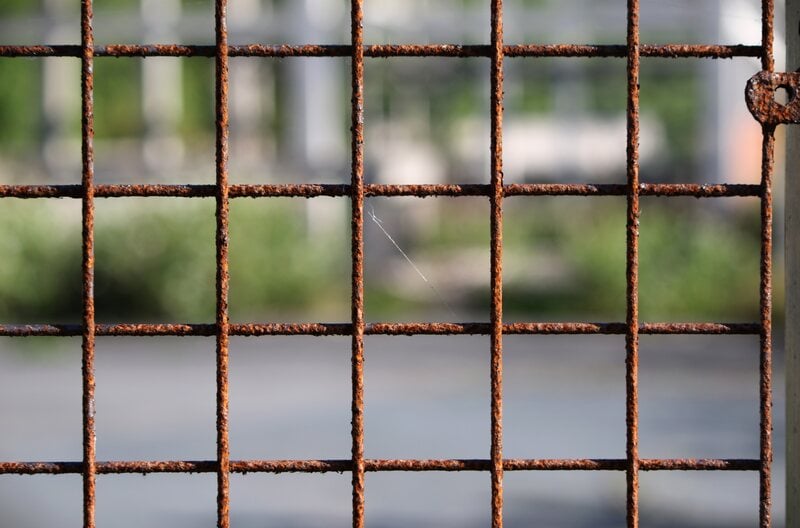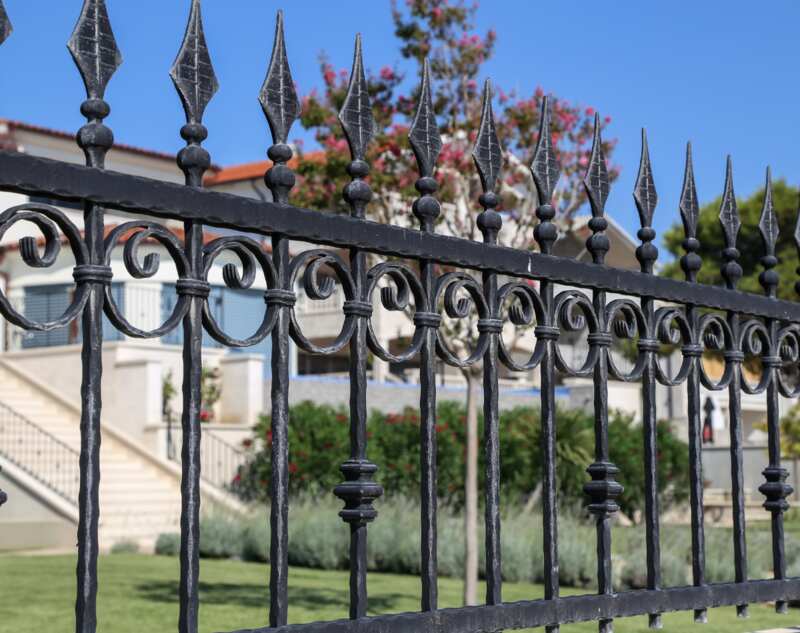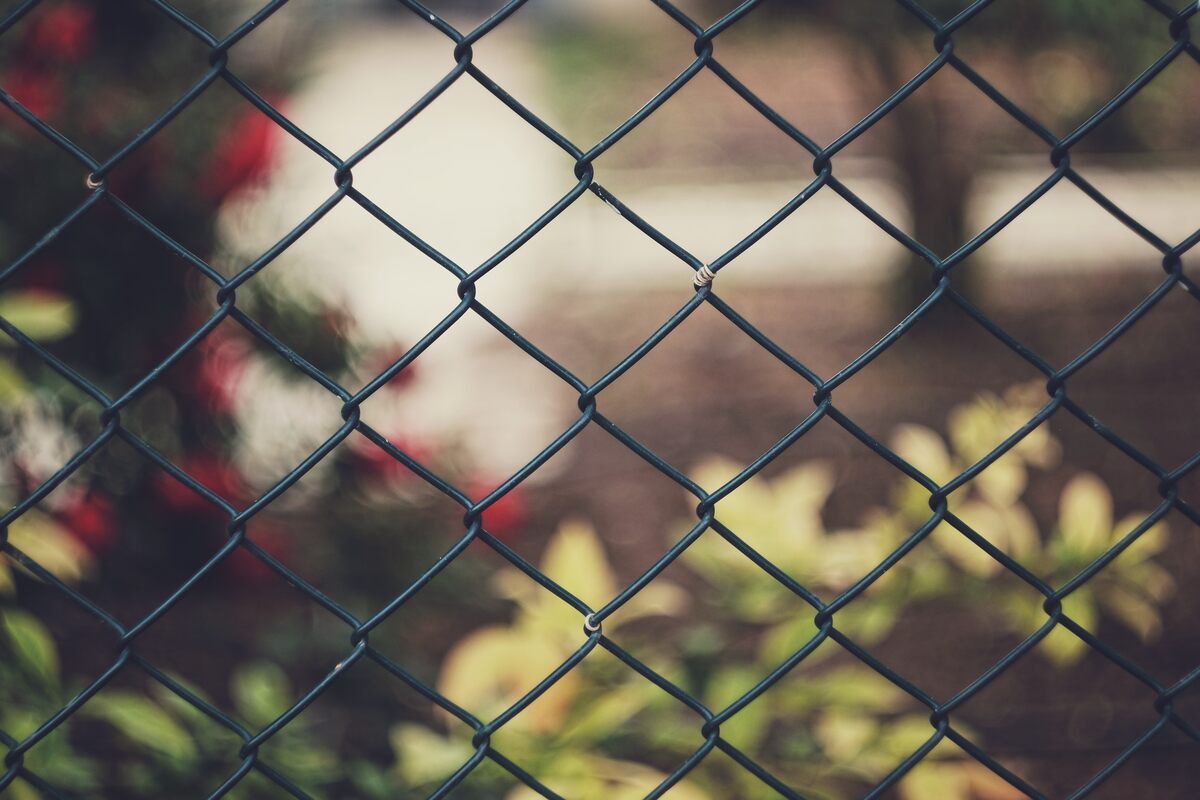
Has your metal fence seen better days? Just because metal fences are low maintenance doesn’t mean they’re maintenance-free. Dirt, chipped paint, loose screws, and rust can all detract from its appearance. If you know how to maintain a metal fence, it will look good year-round and last for years.
Maintenance needs vary by the type of metal, but we’ll go over general tips and tricks that apply to most metal fences. Remember to read all product labels carefully and follow the manufacturer’s instructions for your fence if you have them.
What Is a Metal Fence?
Metal fencing is either made from iron, aluminum, or steel. Homeowners and business owners value this metal for its strength, security, and longevity, making excellent pool fencel and dog fencing. However, metal fences are still vulnerable to denting and corrosion. Rust forms when metal is exposed to oxygen, water, or some acidic substances.
Many metal fences come with black, white, or green paint, but you can choose from a variety of colors on the market. While paint protects your fence from rust, it needs to be maintained to continue having this beneficial effect.
Different Styles of Metal Fencing

Metal fences come in many different designs, such as:
- Wrought iron fences
- Aluminum picket fences
- Steel picket fences
- Chain-link fences
- Wire fences
- Metal privacy fences
Each of these metal fence designs has its pros and cons. More complex styles like wrought iron are more challenging to maintain since you’ll need to clean and repaint all the nooks and crannies in the metalwork.
What You Need to Maintain a Metal Fence
You don’t need tons of fancy equipment to maintain a metal fence. You may already have some of these supplies at home, but you’ll need to stop by the home improvement store for a few more specialized products.
Depending on what state your fence is in, you may need all or some of these materials. Don’t skip the personal protective gear for yourself unless you’re doing a simple wash.
Supplies
- Gloves
- Safety goggles
- Mask
- Trimmers (if you have plants near the fence)
- Tarps
- Soft-bristled brush or toothbrush
- Soap
- Fine wire brush or sandpaper
- Rust converter
- Soft cloth
- Oil-based primer
- Oil-based paint
- Metal-grade wax or sealant
- Spare hardware
- Lubricant
8 Steps to Maintain a Metal Fence

1. Remove Obstacles
Remove any obstacles to get a good look at every inch of your fence. You don’t want to miss a spot while you’re working.
Trim away hedges, bushes, and weeds. Not only will you be able to see better, but it will protect your fence from damage. Plants can shed moisture onto your fence, which increases the chance of rust. Even fallen leaves can retain water, so clear those off as well. Prickly plants are especially bad for fences because they can scratch protective coatings.
Plants growing directly on the fence could cause excess moisture or damage the paint. If you like the appearance of climbing vines, research which types will cause the least damage to your fence type. You also could grow them on a wire frame, lattice, or trellis near your fence for a similar effect without the risk.
2. Protect the Surrounding Area
Once you’ve cleared away everything touching your fence, cover the surrounding area with tarps. This step will protect your yard from the products you use and make cleanup easier.
3. Inspect for Damage

Walk up and down each side of your fence and check for damage from top to bottom. Look for:
- Rust
- Missing parts
- Loose footings
- Leaning posts
- Scratches
- Dents
- Cracks
- Chipped or peeling paint
Make a list of any additional supplies you need. Inspect your fence at least once yearly to avoid severe and expensive damage.
4. Wash Your Fence
Now it’s time to clean your fence thoroughly. This process will make the fence look better and prep it for repainting. Remove the dirt, salt, and other debris with warm, soapy water and a soft-bristle brush or toothbrush. Make sure to thoroughly clean decorative designs like wrought iron so that no dirt remains in the nooks and crannies.
Once you finish, rinse everything off and let dry. This project is perfect for a sunny day since it will dry much more quickly.
5. Check for Rust

Once you clear all the dirt away, look for rust. Wrought iron and steel are prone to rust, while aluminum and galvanized metals are resistant to rust.
If you see a rust spot, use a fine wire brush, sandpaper, or a disc sander and carefully rub it off. You also can use a rust converter, following the package instructions. Always wear goggles and a mask while sanding or applying a rust converter to protect yourself. Wipe the area off with a soft, damp cloth when you finish.
Check for rust twice a year if you live in an especially damp or humid climate. Removing rust spots early will save your metal fence from further damage that could threaten its structural integrity. It also will smooth out your fence in preparation for paint. If the metal has suffered from severe corrosion that’s not just surface-level, you may need to replace sections of the fence.
6. Prime, Paint, and Seal
A clean fence with rust removed is the perfect base for your protective layers. These will stop rust from forming and protect your investment. If the old paint is rough, sand it before repainting the fence. Wear your mask and goggles to protect yourself from fumes, especially if using spray products.
First, apply a couple of layers of oil-based primer. You can use a brush-on or spray primer, but ensure you get it in the nooks and crannies of ornamental designs. Let it completely dry before moving on.
The next step is to paint the fence. Look for an oil-based paint that matches your current fence color unless you want to switch things up. See if the original fence manufacturer sells matching paint. You also can use rust-inhibitor paint to make the metal more durable. Use one or two layers of paint for extra protection, letting it dry between layers.
Apply metal-grade wax or metal sealants after the fence is painted and dried for more rust protection.
7. Replace Missing Parts

If you saw any missing screws, fasteners, or other hardware in your initial inspection, replace them now. You should also tighten loose components to keep them from falling out later. Choose rust-resistant replacement parts if you can. You can paint the new hardware to match your fence, but make sure the parts can still move, if necessary.
8. Grease Gate Hinges
While it’s crucial to maintain the structural integrity of your fence, it’s even more important to keep moving parts working. Use a grease gun and lubricant on the gate’s hinges to prevent squeaking and keep it working smoothly.
How Long Do Metal Fences Last?

You may be wondering if all this maintenance is worth it. A well-maintained metal fence can last between 20 to 100 years, though it varies by specific fence type.
- Chain-link fences last around 20 years
- Steel fences last around 20 years
- Aluminum fences last around 50 years
- Wrought iron fences last around 100 years
Here’s how other fencing materials compare:
- Wooden fences can last around 20 years
- Vinyl fences can last around 30 years
- Masonry fences can last around 100 years
FAQ About How to Maintain a Metal Fence
Generally, you should repaint your fence every two to three years. However, you should repaint it sooner if you notice chipping, cracking, or peeling.
That depends. Here are the pros and cons of each:
Spray Paint
✔ Smooth finish
✔ Quicker painting process
✔ Gets into nooks and crannies
✘ It might spray onto surrounding objects
✘ More risk of inhaling harmful chemicals
Brush Paint
✔ Brush texture (this could be a pro or con based on your tastes)
✔ More control
✔ Doesn’t require special equipment
✘ Takes longer
✘ Harder to paint small nooks and crannies
Out of sight, out of mind, right? Not in this case. Rust isn’t just an eyesore; it slowly eats away at your fence, destroying it in the long run. Painting over it won’t stop existing rust, though it may stop new rust spots from forming. The damage will continue unless you eradicate it.
The number one preventative measure you should take is to minimize moisture. Avoid pointing sprinklers toward your metal fence and redirect other water sources away from the fence. Remove any plants that could damage the fence. Be careful not to chip the protective coating with tools like weed whackers.
When to Hire a Fencing Professional
Sometimes the damage to a fence is too much for the average homeowner to handle. Maybe corrosion has eaten away at the metal post, or brute force has bent the fence pickets. You also might not want to spend your weekend sanding and repainting when you could be relaxing.
A fence contractor will do a thorough job, so you won’t have to worry about missing a step or a section of the fence. And if you want to replace your metal fence with a different style, they can help you with fence installation. Get a quote from a fencing contractor near you to weigh your options.
Main Image Credit: punsayaporn / Canva Pro / License